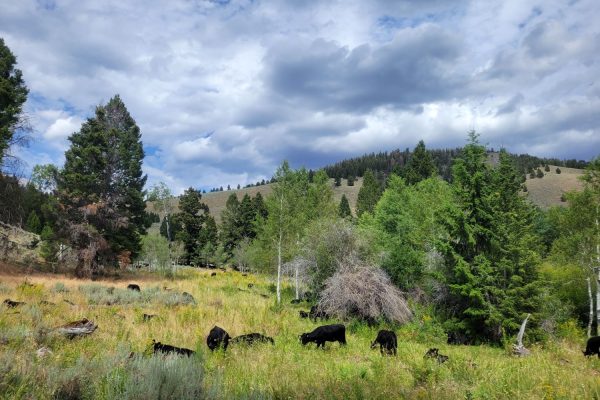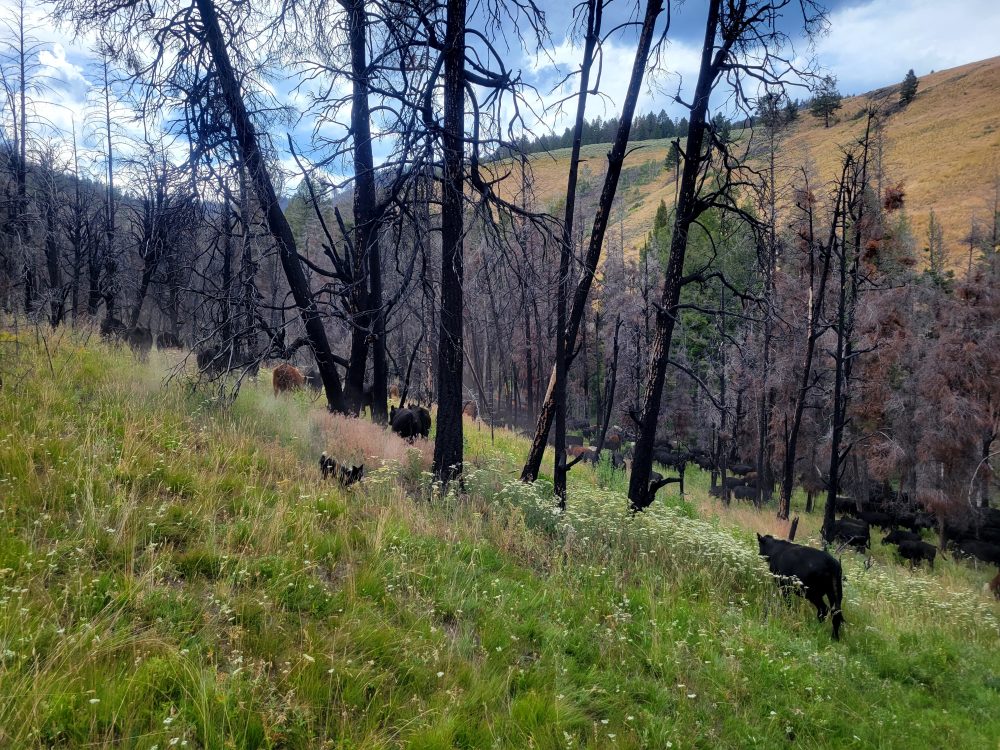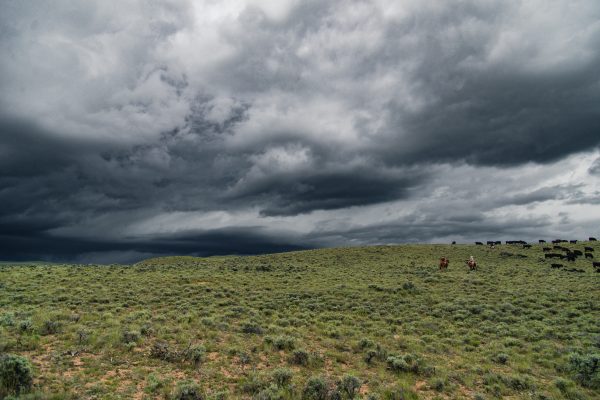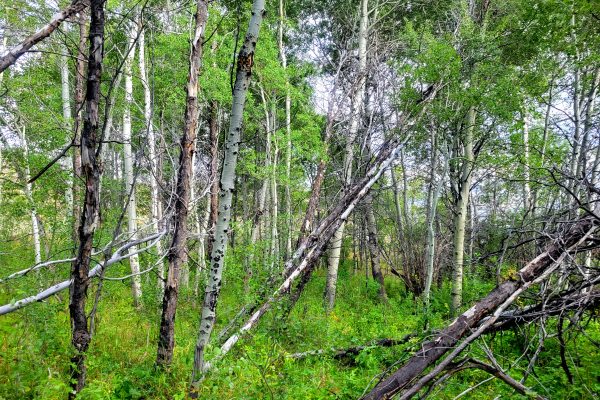It’s been a lovely fall so far with occasional hard frosts, and regular light ones. What that means is there was beautiful aspen gold fall foliage and now there is still lush, green grass. Cool days and nights also stimulate a seemingly insatiable appetite in the beeves. They seem never to have their heads up, except when True the Border Collie boldly comes through to inspect the herd. She holds her ground, and refuses the Border Collie urge to circle and bring them…unless if asked by me. She was a complete nutburger as a pup, but now shows the true colors of black and white as a middle aged matron, anticipating and eagerly awaiting a subtle nod from me.
I won’t give it to her, and she stands immovable as a good dog should, even as the herd of 1200 pound steers surround her. They soon envelop her with curiosity, snuffing and edging ever closer- a bit unnerving for even a border collie.
His observation of one particular herd in Nebraska is exceptionally vivid. Here it is, unedited, as Warren Ferris penned it in 1830:
Next day, oh, there they were, thousands and thousands of them! Far as the eye could reach the prairie was literally covered, and not only covered but crowded with them. In very sooth it was a gallant show; a vast expanse of moving, plunging, rolling, rushing life – a literal sea of dark forms, with still pools, sweeping currents, and heaving billows, and all the grades of movement from calm repose to wild agitation. The air was filled with dust and bellowings, the prairie was alive with animation, – I never realized before the majesty and power of the mighty tides of life that heave and surge in all great gatherings of human or brute creation. The scene had here a wild sublimity of aspect that charmed the eye with a spell of power, while the natural sympathy of life with life made the pulse bound and almost madden with excitement. Jove but it was glorious!
And the next day too, the dense masses pressed on in such vast numbers, that we were compelled to halt, and let them pass to avoid being overrun by them in a literal sense. On the following day also, the number seemed if possible more countless than before, surpassing even the prairie blackening accounts of those who had been here before us, and whose strange tales it had been our wont to believe the natural extravagance of a mere traveler’s turn for romancing, but they must have been true, for such a scene as this our language wants words to describe, much less to exaggerate. On, on, still on, the black masses come and thicken – an ebless deluge of life is moving and swelling around us! (From “Life in the Rocky Mountains” by Warren Ferris, ca 1830.)

That was three days that the moving herd reached to the horizon, and darkened the prairie for Mr. Ferris’ party. When calculating the sheer numbers of this herd, based on the average distance apart and using a minimal rate of speed while moving through, I come up with from 5-8 million animals in this one group. Guessing perhaps 10 herds out on the whole of the tallgrass prairie (supported by other accounts), now known as the cornbelt, we are easily up to 30-50 million head of bison.
The US beef production system, said by some to be the most efficient on the planet, doesn’t hold a candle to what nature produced on that tallgrass prairie–on a fraction of the lands now used today in beef production. Every state in the US now produces beef cattle. Most of them (over 98%) are fattened on corn raised not only in the cornbelt, but throughout the Nation in the rainier east, and on irrigated croplands in California, Idaho, Montana and Colorado. The 30 million head of beef produced in the US today are likely equal to or less than what was produced in bison every year on just the 12 or so states that supported productive prairie. This doesn’t even count the ancient production that occurred on many of the other lesser buffalo lands like here in Idaho, Utah or Nevada.
What this flies in the face of is the incessant chatter that we need to stop the production of beef for the sake of environmental health. The fact of the matter is that nature has long been in red meat production, even in excess of what we produce in our country today. I would argue that it is not beef production per se that is the problem, but rather the model by which we produce most of the meat raised in this country today.
The differences in this prehistoric red meat paradigm can be summed up in one word: health. Health existed in nearly every aspect of the holistic production paradigm nature practiced. Everything from the tiniest soil biota and the carbon sequestration tied up in intact grasslands to huge herds of thundering hooves over them, and a much clearer big muddy (Missouri and Mississippi Rivers) emptying into the Gulf of Mexico.
And as you could guess, the protein produced in this prehistoric paradigm was far more nutrient dense that what corn-fed has done to beef today. The health benefits extended to even the eaters of the bison as well. It can be surprising to people how productive our native rangelands can be when people act as the top predators now missing from our environment and cattle are used as a management tool to mimic the native buffalo. Pictures of degraded rangeland show so little forage it would be hard to feed a rabbit, much less a cow. But even arid western ranges can be highly productive and produce many pounds of health-giving wild protein. The key is care and management.
Although I am very proud of what we have done on our 48,000 acres of native mountain rangeland (which, incidentally, I recently discovered is fully one percent of the certified organic acreage in the entire US), I love seeing what other people are doing. Dan, a friend of mine, lives out on what was once the edge of the tallgrass prairie in arid western South Dakota. Some of this native prairie has been converted to cropland; much of the rest is degraded and suffers from non-native grass invasion. Dan ranches out there, running 600 Black Angus mama cows on about 30,000 acres of prairie (he’s certified organic as well). Some of the more vulnerable native tallgrass prairie species are gone, and he is trying to reestablish them. The most notable grass, perhaps the definitive grass of the tallgrass biome was big bluestem. Big is a key word here. It’s the plant he has been trying to focus on in much of his restoration projects. I spoke to him on the phone about it, a little over a week ago.
“How’s your big bluestem restoration going, Dan?”
“Very well. The rains we have had this year have really helped. And there are spots of still native bluestem on prairie remnants surrounded by the [very rocky and inpassable cliffs on] Badlands just west of here. In fact, one of my neighbors was up on one of them horseback last week. He said the bluestem was very thick, and over the height of his shoulders when he was on horseback. That’s nearly 8 feet tall.”
That basically collides head on with the idea many of us have of grass. We picture our front yard. Somehow, that’s what we picture grass fed beef eating. No wonder it seems like it could take a lot of acres. Now consider 10 Midwestern states covered with grass of the stature of bluestem. Or consider our Idaho native grasslands with the 8 foot tall basin wild rye that once covered large valley basins like our own Pahsimeroi.
Suddenly, the sheer production of these ancient natural systems makes sense, and it starts to get very intriguing about how we can replace our current corn-driven cattle feeding paradigm with one that mimics the ancient bison herds and the resilient health of our native grasslands.
It’s part of what gets us really excited and passionate about what we do here on Alderspring. The lessons nature has given us are sometimes hard to uncover, but putting together the pieces from old trapper journals, recent science on grazing, and stories from fellow producers is a fascinating journey in the quest to provide the very best beef to our patrons while leaving a legacy on the ground.
Thanks for supporting us in this journey, and for coming along for the ride!







Dana Austin
Wonderful article here! Thank you for this enjoyable reading, Glenn You left out the Bison Belch good news to back up your claim that in essence not all cattle raising is a methane powerhouse. I’ve been reading and hearing that the bison and cattle raised on these wonderful grasslands dont emit nearly as much methane into the atmosphere because of the specialty bacteria in the soil. So herds such as yours are not contributing to the methane overload in our atmosphere.
Shirley
I’m always amazed at how hard you work on keeping Alderspring truly organic and regenerative. I’m also hoping you got the message through to those “can’t think outside the Washington DC box†legislators that you met with last week. Idaho and DC are truly two different worlds!
Deb Olsen
Always educating yourselves by learning about the past and where we went wrong. I have the highest level of respect for all of you and I sure hope the people in Washington realize how important your mission is and that they work with all ranchers like yourselves that want to make a difference and turn back the clock to restore lands to their native beginnings or get as close as we can. You strive for all of this and I thank everyone from the bottom of my heart!
Sara Schoen
Please keep sharing this message with lawmakers/on the Hill. -Sara in DC (and yes it’s too noisy here at night… can’t sleep with the windows open… so glad you appreciate all you have 🙂 )
Tom Irvine
Time for you to write a book, Glenn, a NY Times bestseller. This information needs to be more widely known.
Cary Schwarz
100% agree. Having known Glenn and Caryl for nearly 40 years, I’ll be shocked if that is not on the planning schedule.
Dan Rasmussen
Glenn, thanks for putting the importance of soil health front and center where it belongs. A corn plant puts roots down 6″. Big Bluestem grass roots go down 15 feet. This is nature’s way of healing the damage corn and soybeans are doing to our valuable soil. We need more land managers willing to plant the native grasses Glenn talks about, next to rivers, on steep hillsides and in many places corn and soybeans are now being raised. If you study nature closely enough she will give you the answers to maintaining a healthy planet. These answers do not include fake meat that promotes more bean fields. Getting rid of belching cows results in fewer acres of native grasslands. These urban legislators need to hear from more ranch families like the Elzingas.
Your friend in Big Bluestem country, Dan